Only one of Ohio’s 12 species of frogs is poisonous. Learn to identify these fascinating amphibians and where to look for them. You’ll want to know which frog’s skin produces a poison so potent it kills some animals who eat them. While you’ll likely not be tossing any of these frogs into your mouth, even touching Ohio’s poisonous frog can produce a nasty rash. The 12 types of frogs in Ohio are all covered here in this article. Happy frogging!
Amphibians in Ohio
Unlike reptiles, amphibians don’t have scaly skin and most prefer to come out at night. They are cold-blooded animals that drink and breathe through their moist, soft, glandular skin. Amphibians get their name from the Greek terms amphi, which means dual, and bios, meaning life. The duel aspect of their name could refer to how most amphibians live half their lives in water and half out. It could also describe the metamorphosis amphibians pass through when they are young from an aquatic form to their adult anatomy.
The majority of amphibians in the world are toads and frogs, followed by salamanders and a minority of caecilians. There are 36 species of amphibians that call Ohio home. Of those, 15 are frogs and toads. While similar in form, frogs generally have moist, relatively smooth skin and leap. Toads, on the other hand, have dry, warty skin and hop.
Check out the Department of Natural Resources publication Amphibians of Ohio Field Guide.
The 12 Types of Frogs in Ohio
The Ohio Frog and Toad Calling Survey reports that there are 15 frog and toad species in four families found in Ohio. While all amphibians are under pressure from habitat loss and pollution, Ohio’s Department of Natural Resources (DNR) formally lists only one frog species as a species of concern. Ohio’s DNR lists one toad species, however, as endangered. Salamanders make up the remaining six endangered and threatened species of amphibians on the department’s list.
The good news for those of us out looking for frogs in Ohio is our amphibious little friends generally seem to be doing well. Let’s take a look at who we can find croaking the night away in Ohio’s swamps and trees!
#1 American Bullfrog
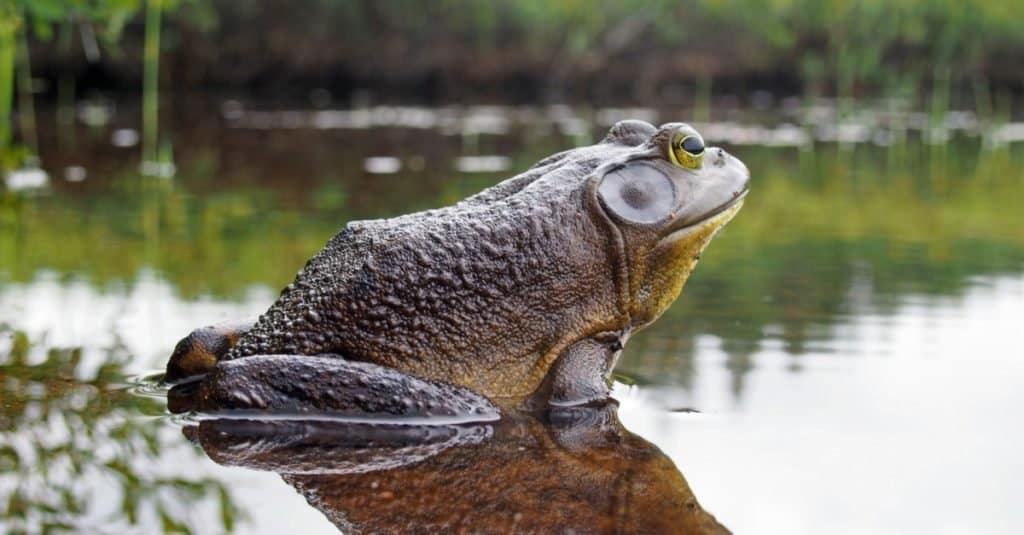
North American bullfrogs got their name from their mating calls that sound like the bellowing of a bull.
©Christian Ouellet/Shutterstock.com
Scientific Name: Lithobates catesbeianus
Family: Ranidae — The “True” Frogs
Description:
- The American bullfrog is the largest frog in Ohio. It can grow to weigh up to 1.5 pounds. Adult body length can range from 3.5-6 inches.
- Bullfrogs are typically olive green or some shade of brown occasionally with some darker spots on the back.
- The species has a mottled with gray chest and its belly is off-white.
- There are no dorsolateral folds along a bullfrog’s back.
- There is extensive webbing on the back feet that almost reaches the tips of each toe.
- When calling, a bullfrog’s throat will swell, but its vocal sac will not be visible as it is internal.
- Bullfrogs are not picky about their meals. They will eat almost anything they can fit inside their huge mouths. They regularly prey on other frogs, fish, turtles, insects, crustaceans, worms, and even small birds, bats, and rodents.
Listen to their calls here.
Where to Find Them: Bullfrogs are not picky about their homes either! Any permanent body of water in Ohio, including swamps, ponds, and lakes, is a good place to look for a bullfrog.
#2 Northern Green Frog
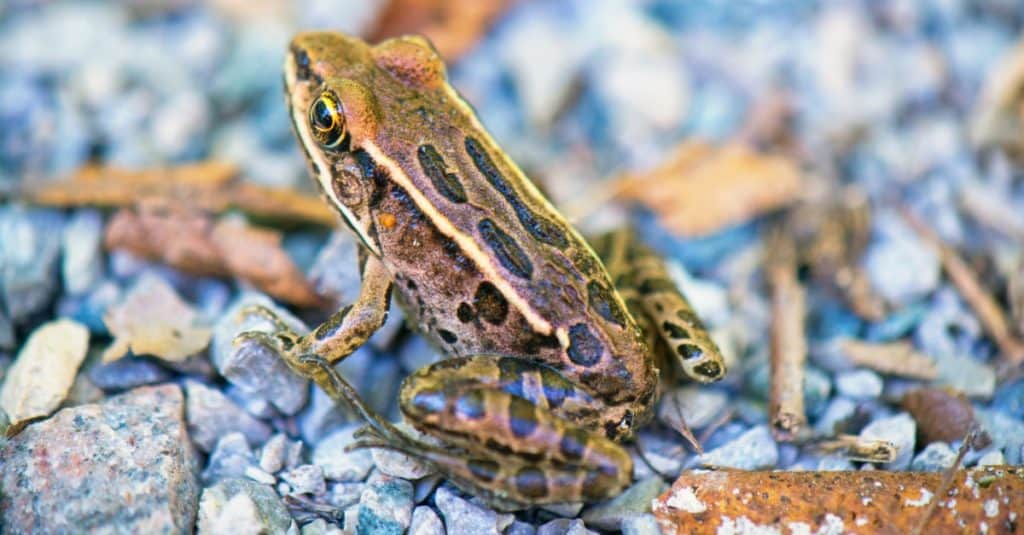
Northern green frogs sound like the strings of a plucked banjo.
©iStock.com/rgbspace
Scientific Name: Lithobates clamitans
Family: Ranidae — The “True” Frogs
Description:
- Northern green frogs are one of the easiest species of frogs to find in Ohio.
- Adults grow to 2.25-3.5 inches. Females are usually larger than males.
- Green frogs are (surprise!) green to brownish-green.
- They have a white belly and chest with possibly some black mottling.
- Their most identifiable feature is a pair of dorsolateral folds that extend from behind the tympanic membranes to a little more than halfway down their backs.
- You will not see the male’s vocal sac when he calls as the sac is internal, although his throat will swell.
- Listen for the sound of a banjo being plucked in the pond and it’s likely the northern green frog calling.
Listen to their calls here.
Where to Find Them: Northern green frogs are distributed in every part of Ohio inhabiting most aquatic environments.
#3 Pickerel Frog
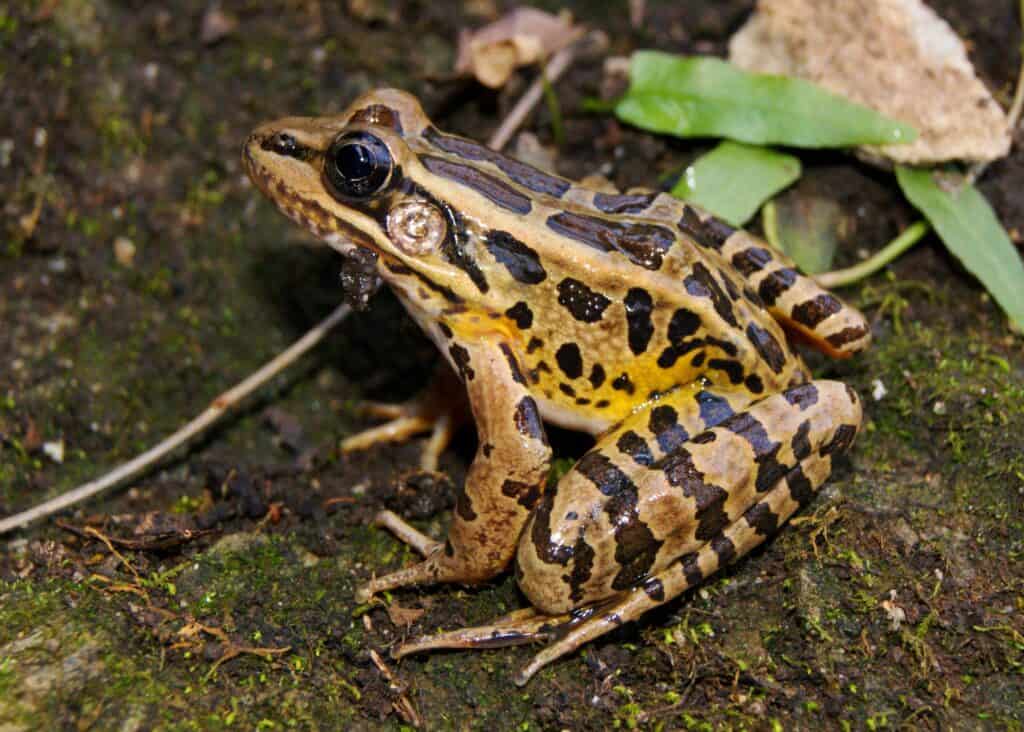
Pickerel frogs are Ohio’s only species of poisonous frog!
©Matt Jeppson/Shutterstock.com
Scientific Name: Lithobates palustris
Family: Ranidae — The “True” Frogs
Description:
- Pickerel frogs are the only poisonous frog native to Ohio!
- Adults grow to between 2-4 inches.
- Pickerel frogs are tan, light brown, or olive green on their backs with a white belly. Two rows of square spots run down their backs. They have a bright yellow color on the underside of their hind legs.
- Males have paired vocal sacks.
- You will hear a long, low snore-like sound when males are calling for a mate.
Listen to their calls here.
Where to Find Them: According to the Ohio Frog and Toad Calling Survey, pickerel frogs can be found throughout the eastern half of Ohio. These frogs “utilize the margins of clear, cool streams, woodland springs and seeps, fens, and wet meadows.”
#4 Northern Leopard Frog
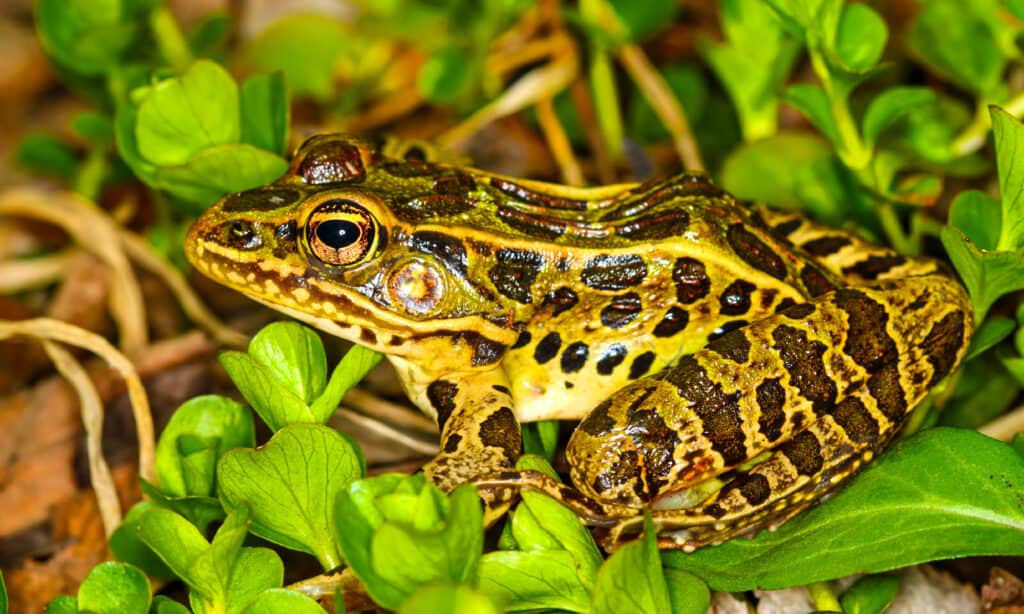
Northern
leopard
frogs are showing evidence of decline in Ohio.
©Jason Patrick Ross/Shutterstock.com
Scientific Name: Lithobates pipiens
Family: Ranidae — The “True” Frogs
Description:
- Northern leopard frogs grow to be from 2-4 inches.
- They can be green, brown, or tan with an immaculately white belly.
- Their skin is smooth except for two or three rows of raised ridges that extend down the back.
- Northern leopard frogs have a light line just above their upper jaw.
- Males have paired vocal sacs.
Listen to their calls here.
Where to Find Them: Northern leopard frogs can be found throughout Ohio except the southeastern part of the state. The frog is still abundant in its habitats but surveys show evidence of decline as wetlands continue to be drained. Northern leopard frogs inhabit saturated meadows, slow-moving streams, and lake margins with lots of vegetation. They are also found in agricultural areas.
#5 Southern Leopard Frog
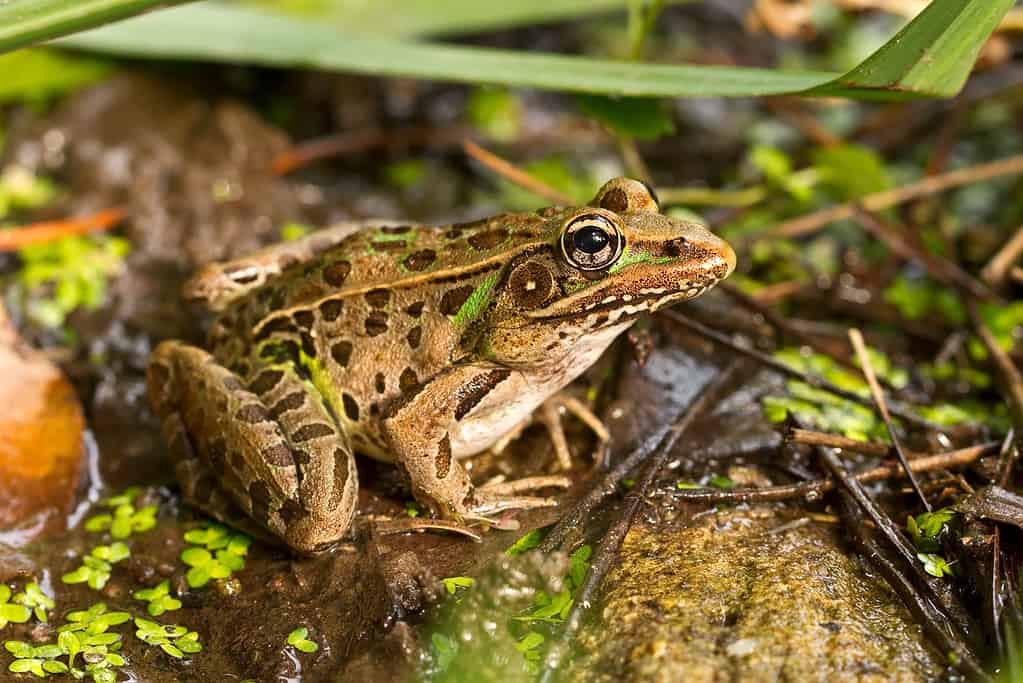
The southern
leopard frog
is Ohio’s rarest species of frog.
©LorraineHudgins/Shutterstock.com
Scientific Name: Lithobates sphenocephalus
Family: Ranidae — The “True” Frogs
Description:
- The southern leopard frog is extremely rare in Ohio.
- They grow from 2-3.5 inches.
- They are green or brown with white bellies and dark spots all over their bodies.
- A light line runs from each eye down their sides.
Listen to their calls here.
Where to Find Them: Southern leopard frogs have only been found in extreme south-central Ohio in a wide variety of aquatic habitats.
#6 Wood Frog
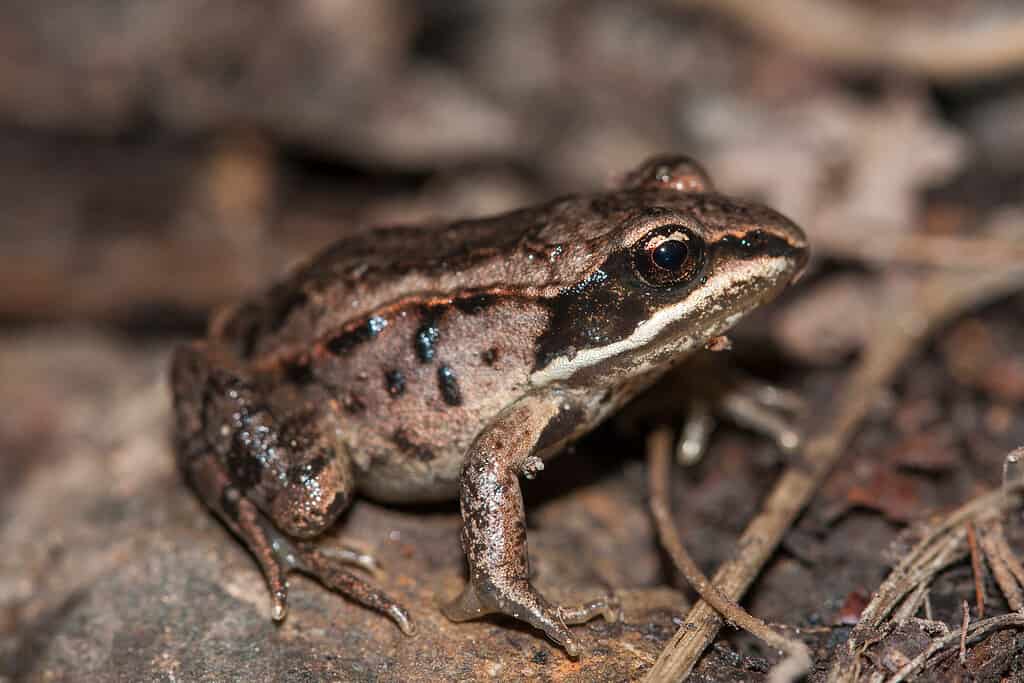
Wood frogs, like many frog species, are capable of freezing over the winter and defrosting in spring.
©Viktor Loki/Shutterstock.com
Scientific Name: Lithobates sylvaticus
Family: Ranidae — The “True” Frogs
Description:
- Wood frogs are capable of freezing over winter and reemerging in the spring!
- They are one of the first frogs to make an appearance after the snow melts.
- They grow from 1.5-3 inches.
- Wood frogs are usually dark brown or tan, although some individuals have been found with pink to red coloring.
- They have distinct markings around their eyes that resemble a mask.
Listen to their calls here.
Where to Find Them: Wood frogs are abundant in much of southern and eastern Ohio. They live in woodlands with deep, moist soil.
#7 Blanchard’s Cricket Frog
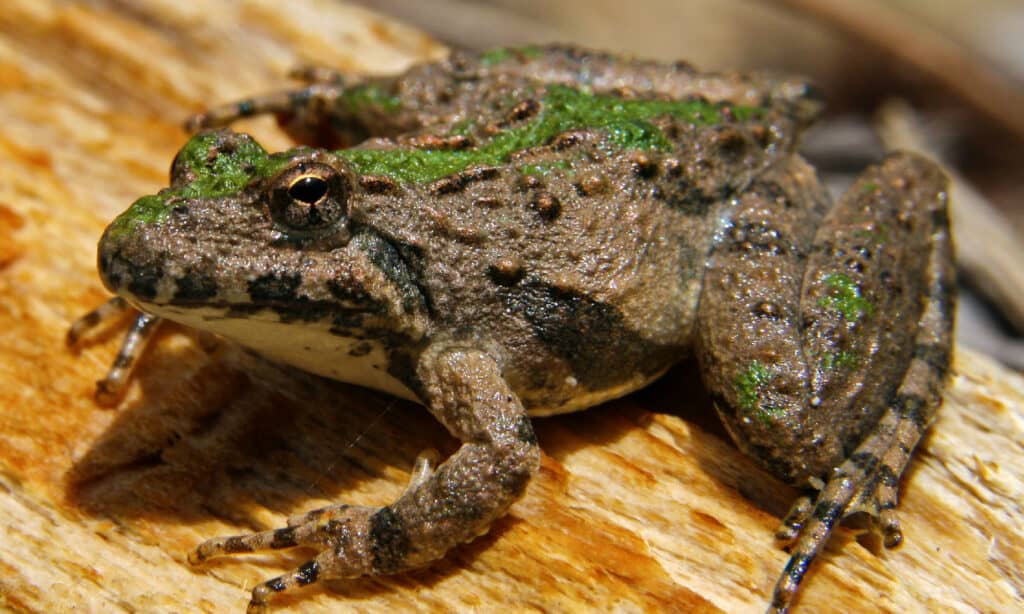
Blanchard’s cricket frogs have an overbite you can see when you view their profile.
©Ryan M. Bolton/Shutterstock.com
Scientific Name: Acris crepitans blanchardi
Family: Hylidae – The Treefrogs
Description:
- Blanchard’s cricket frogs are on the smaller side growing from 0.6-1.5 inches.
- They have warty skin that is typically brown, gray, or olive-colored.
- A dark triangle can be seen directly behind their eyes.
- The belly is white.
- Viewed from the side, they have an overbite with their top jaw extending beyond the bottom jaw.
- Males have a visible vocal sac.
Listen to their calls here.
Where to Find Them: Although rapidly declining across much of its range, Blanchard’s cricket frog is found in the western two-thirds of Ohio. They like open, sunny areas along aquatic shores where algae and vegetation are abundant.
#8 Cope’s Gray Tree Frog
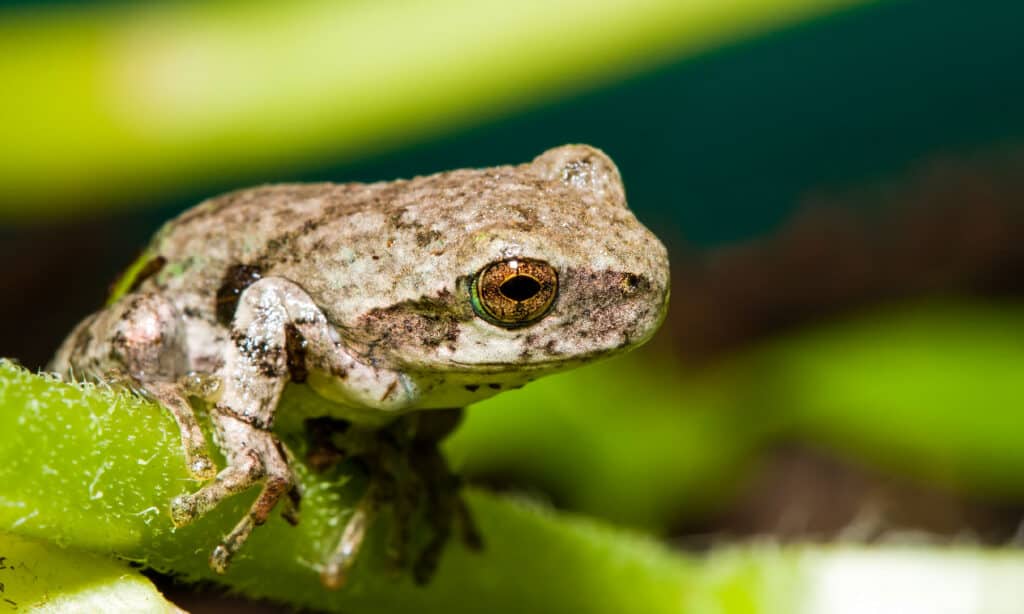
Cope’s gray tree frogs can change their skin coloring to match their surroundings.
©iStock.com/Coffee999
Scientific Name: Hyla chrysoscelis
Family: Hylidae – The Treefrogs
Description:
- Cope’s gray tree frogs are 1.5-2 inches.
- Their skin is warty with a gray coloring that may also be green.
- They are capable of camouflaging their skin to match their surroundings.
- Cope’s gray tree frogs have a white patch under each eye.
- A bright yellow flash mark is visible inside of each thigh.
- Like most tree frogs, they have large toe pads.
Listen to their calls here.
Where to Find Them: Cope’s gray treefrogs only inhabit the southern third of the state. They inhabit swamp forests and woodlands but may be found in trees far away from water.
#9 Gray Tree Frog

A grey tree frog is physically identical to a Cope’s gray tree frog.
©Aleksandr Kondratov/Shutterstock.com
Scientific Name: Dryophytes versicolor
Family: Hylidae – The Treefrogs
Description:
- Gray tree frogs are physically indistinguishable from Cope’s gray tree frogs.
- The difference between the two is that the Cope’s gray tree frog has two times more chromosomes than the gray treefrog. Also, the gray treefrog’s red blood cells are larger than those of the Cope’s gray tree frog.
- The only outward method of distinguishing the two species is by their calls. The gray treefrog makes more of a short, flute-like trill. A Cope’s gray treefrog has a faster, higher-pitched trill.
Listen to both species of gray tree frog calls here to contrast the two.
Where to Find Them: Gray tree frogs are widespread across Ohio. They are found in trees or shrubs near water.
#10 Mountain Chorus Frog
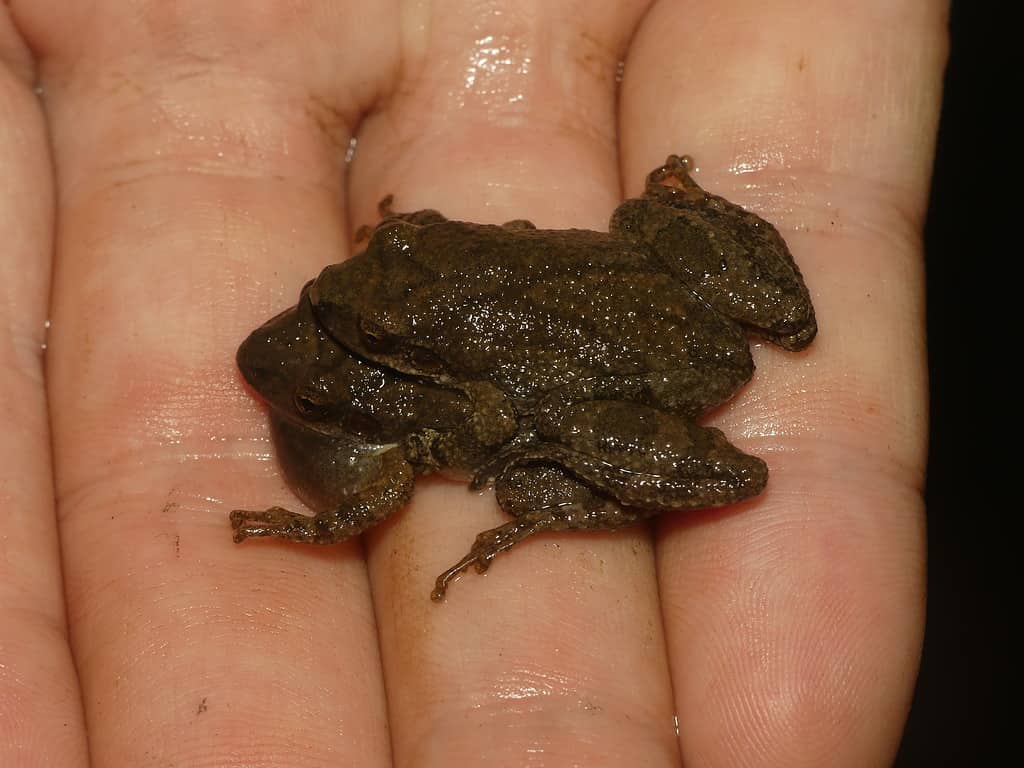
Mountain chorus frogs have a mark on their backs that resembles a reverse parenthesis.
©no rights reserved/CC0 – License
Scientific Name: Pseudacris brachyphona
Family: Hylidae – The Treefrogs
Description:
- The mountain chorus frog is a secretive species that grows from 1-1.5 inches.
- They are gray to olive-colored with a marking on their backs that resembles a reverse parenthesis.
- As is typical of chorus frogs, this species has a white line on its upper lip.
- They can be distinguished from a spring peeper by a dark triangle between their eyes.
- Males have a mid-line vocal sac.
Listen to their calls here.
Where to Find Them: Mountain chorus frogs are restricted to the unglaciated portions of the Allegheny Plateau in southwestern Ohio. These frogs can be found on moist, wooded hillsides, especially around water sources.
#11 Northern Spring Peeper

The northern spring peeper has a mark resembling an “X” on its back.
©Jay Ondreicka/Shutterstock.com
Scientific Name: Pseudacris crucifer crucifer
Family: Hylidae – The Treefrogs
Description:
- Northern spring peepers are small frogs that range between 0.75-1.5 inches.
- They can be yellow, olive, tan, reddish, or brown. The females are generally lighter in color.
- Both males and females have a distinguishing mark resembling an “X” on their backs.
- Males have a mid-line vocal sac.
Listen to their calls here.
Where to Find Them: The northern spring peeper can be found throughout Ohio. They live in swamps and moist woodlands staying on the ground under cover of dead leaves and rotting logs.
#12 Western Chorus Frog
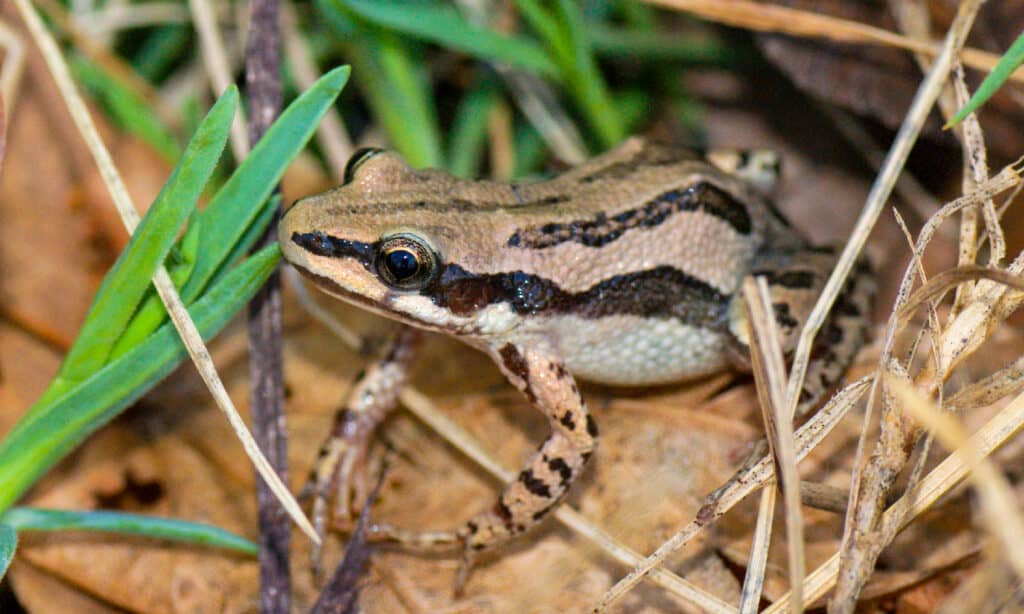
Western chorus frogs have expanded their range outside of prairies as woodlands disappear.
©Matt Jeppson/Shutterstock.com
Scientific Name: Pseudacris triseriata triseriata
Family: Hylidae – The Treefrogs
Description:
- Western chorus frogs grow to between 0.75-1.5 inches.
- They have smooth skin that varies between green, brown, gray, or tan.
- There are usually three distinctive dark lines extending down the length of their bodies.
- Males have a mid-line vocal sac.
Listen to their calls here.
Where to Find Them: Western chorus frogs appear to be doing well in Ohio and range across the entirety of the state. This frog was originally limited to prairie land but as people have cleared the eastern woodlands the species has been able to extend its range. Western chorus frogs live in a variety of habitats such as ponds, marshes, swamps, meadows, and grassy pools.
Summary Table of the 12 Types of Frogs in Ohio
| Number | Name | Family |
|---|---|---|
| #1 | American Bullfrog | “True” Frogs |
| #2 | Northern Green Frog | “True” Frogs |
| #3 | Pickerel Frog (Poisonous) | “True” Frogs |
| #4 | Northern Leopard Frog | “True” Frogs |
| #5 | Southern Leopard Frog | “True” Frogs |
| #6 | Wood Frog | “True” Frogs |
| #7 | Blanchard’s Cricket Frog | Tree Frogs |
| #8 | Cope’s Gray Tree Frog | Tree Frogs |
| #9 | Gray Tree Frog | Tree Frogs |
| #10 | Mountain Chorus Frog | Tree Frogs |
| #11 | Northern Spring Peeper | Tree Frogs |
| #12 | Western Chorus Frog | Tree Frogs |
The photo featured at the top of this post is © Tau5/Shutterstock.com
Thank you for reading! Have some feedback for us? Contact the AZ Animals editorial team.






